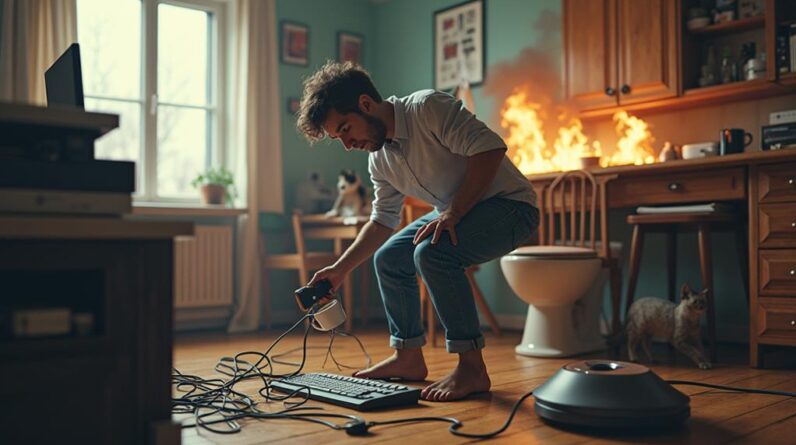
Here is a step by step process how to build a home on wheels. Once you have purchased the van, schedule it. Always start with the largest dimensions and requirements. My request was to store e-bikes, without having to disassemble them. This dictates the whole layout. The bed would be too high, so I have to figure out the position of the ebony, so that it can be as low as possible. Because we planned to live in the van, we needed as much space as possible in the main space, so we can move around without going crazy 🙂 In the next step, you should disarm the car Get out from the inside everything that doesn't have to be there. In our case, that was all … the partition, the seats, all panels and covers. Make all mechanical repairs right at the beginning. This is important before you go anywhere. You want to have a fully functional and secure delivery, so make sure it is For some people, it may just be an oil change, for someone else a timing belt, rubber, this is just too individual.
Once the car is healthy and confident, make sure you can use it. You need a seat for that 🙂 Swivel mechanisms are essential for us. But they are quite expensive and I was not willing to pay $ 300, for each of them. I found a couple of cars that have swivel seats at the base, and found these seats used on the internet. All that was needed was to make brackets on which to attach the seats. Fun project and opportunity to train welding. Others are windows and skylights. Let's do the main things right at the beginning. Decide where you want them and cut holes. I also made a simple wooden frame to level the whole roof. The window snaps into each other like a sandwich, and needs a solid foundation for proper installation. Just make sure the outside of the window is properly sealed. To do this, you need a good adhesive that is resistant to which is well resistant to weather conditions. This I believe is skipable for most people and it's a color. First of all, I did some kiting and thus filled in some imperfections. In the second row, I ran around the car with a fine emery and abraded loose particles of paint and rust.
In the third step, I washed and degreased the entire surface of the car. I know what I'm going to do is not conventional, my project, my rules 🙂 I decided to just roll the paint on the car. Why? It is the cheapest way and at this stage I believe it is the fastest. I sprayed all the folds first so I wouldn't see the brush strokes. That means the door from the inside, the roof and all the curves around the van. Then I'll make two layers. I have to read the result, it is quite good.
Scratching a car doesn't stress me at all. If I scratch it, I'll do another coat for a few dollars. There are a lot of ready-made water tanks for campers, which you should use. I personally would never make a tank inside a car, if it is possible to have them from below. The reason is, of course, saving space. I have a small budget, so I make my own tanks from barrels.
It's more work but I like these projects. I connect four 25l canisters together and so I create a 100l tank for clean water. The other two together on 50l of dirty water. These canisters fit perfectly from under the car and I welded a plywood support frame to them. In this way, the tanks are covered, protected and really pressed to the bottom of the car. Solariums are easy, you can buy handles for mounting for delivery, as well as cable glands.
I didn't buy them, I cut the aluminum angle instead, drilled holes and glued / screwed with self-cutters. I just drilled holes in the cables and these were subsequently insulated with the same sikaflex adhesive. A quick and easy solution that will do the job. The reversing camera is also easy. This one was cheap from ebay and I read in the comments that he was running into it after the rain. Seamlessly. I siliconized it all around and it is suddenly waterproof. In the next step you can make cables or insulation, whatever you prefer first. I decided to make cables. All should be in protective tubes, so that they do not accidentally cut themselves somewhere. I learned this later, so avoid it. Plan everything with a handle like me, that's a good way. This is easy to work with. Schedule lights, switches, reversing camera, voltage converter, water pump, fan and everything else you will add. I also added a winding drum with a cable from under the car, because it is very practical to just pull the cable to connect. Make sure you have enough USB everywhere. A good trick for camping in the streets, I made the transition to car charging stations.
That's how I can connect the whole car, use inside electricity, charge electric bikes and the like. It's also a good thing to have a traction battery charger, because when you connect to the mains, you start charging them automatically. Another is isolation and there are many ways to isolate. This topic is so broad that you have to study it yourself. I decided to make 18mm double sided chrome mirelon In this case, it is important to cover everything with panels and leave air gaps.
I sprayed contact glue on both surfaces of the car and the insulation and then just pasted as a sticker. My friend Richie is helping me I measure, he cuts the shapes and the whole phase took us only a few hours. Easy! Finally, we get to more interesting parts. Again, several ways to make floors. The way I do it, is raising and leveling the floor, using the same insulation. It is good to use lightweight plywood as a board. It's quite expensive, so I use scraps that roll in my workshop.

On top, I glued vinyl for commercial use with contact glue. This one is more durable and harder to scratch. I measured the ceiling panel and cut it from 3mm MDF. I made sure that all the holes would fit and also marked the lights. Here in the video I use a thick, black fabric, which I had extra in the workshop. It ensures a softer and more pleasant final impression. The second layer is the fabric I use for the panels to have a uniform look. I also made three supports from chipboard.
These shapes copy the inner shape of the roof and I attached fabric to the edges so as not to damage the new ceiling panel. Assembling the panel was pretty easy with all this. I use the same PU glue Mamut and the panel is firmly pressed to the ceiling. The next morning, the glue was dry and I could move on. Another thing to do is the panels. Cover all insulation. Some people use wood to completely cover the entire van. This is good for a specific look and for insulating the supply even more. I like the modern look and panels are the way for me. First I glued the fabric with contact glue on the visible load-bearing parts of the car.
For example, under the upper cabinets. I cut MDF strips in some places and glued them with a mammoth overnight to have a solid base for gluing the fabric. One panel above the back door requires more attention, because it's a complicated shape. It can be seen that I use a plastic plate which I first cut and then bent fit and cut in the car. He later upholstered with two layers of cloth. I made templates from cardboard and converted the shapes of the panels to MDF. The rest is just carving them. Same principle as for the ceiling panel. Thick black fabric first and then my interior gray. The screen is painted, thicker, 8mm MDF I'll attach things to it later so I need stronger support. I use a 1mm painted, sheet metal plate for the side door, on which I made a grate in the previous step, so I can just stick it with a mammoth.
Different people use different materials for furniture. I can easily say that lightweight plywood is best. It is quite strong, does not twist with moisture and is super light. I didn't have the financial benefit of working with plywood, so I use the free material I have in the workshop. So I use 18mm laminate, commonly used in Europe for furniture. Ebiks are the biggest load dictating the layout inside, so I loaded them he made sure they fit and marked their dimensions on the floor, the sidewalls. On this basis, I immediately knew the size of the kitchen, electrical cabinets, input cabinet and how much space I have for the garage unit.
I start with the upper cabinets, I make the frame as light as possible that is, cutting the strips, edging and tailoring them. It's pretty easy, I use it on my back 3mm plastic belt, which I also had in the workshop, because it bends easily. Before I staple it on the cabinets, I glue the black fabric to the front side with contact glue in advance.
Installing cabinets in a car is a job for one person, as you can see, using self-cutters in the supporting structure of the car. In these photos you can see the first phase of the kitchen, her planning, sink, stove … Here I already have a kitchen on the table and I work on it. I make sure everything fits. Yeah. Here is the first test of the projector, which makes me very happy to this day. It was the idea of one of my friends and I immediately fell in love with it. Very cheap, 720p projector that runs on 12 volts and costs just over $ 100. Here you can see the rotating mechanism for expanding the table Here we already have the main mood and the main residential area. It is the first phase, here you can also see the groove on the canvas and here the canvas is already mounted. This is a garage unit that helps with organization and it also has a safe.
Once you've installed all the furniture, it's time to put it all together. Stretch LEDs, switches, water pump, flashlight, fuses, reversing camera, refrigerator, etc. This is a very satisfying phase, because you see the final product. It feels great! In our case, we are finishing the bed, because we no longer need easy access from behind the car. This means welding the frame and fitting the guide, and prepare everything for motorized pistons, which will lift the bed up. This last phase is a lot of fun. It's about adding things and features, into your fully functional motorhome on the fly.
As you begin to use the van, you will become aware of a number of patterns of behavior and with a pinch of critical thinking you realize how to do it better. We've added so many things since day one. As a cutting board, spices, paper napkins, laptop holder, extra USB, temperature station, mirror, hangers … It's so fun to make the space more populated, useful and personal. I see you got to the end, so now you have to look at the tour with our van, and take a look at all the creative details and how we operate inside. If you want to see how we travel and where we are right now, so Margaret look at Instagram like @Curlyhaircamping and on mine as @Panorama_mann See you at the next video!.
As an Amazon Associate I earn from qualifying purchases.







